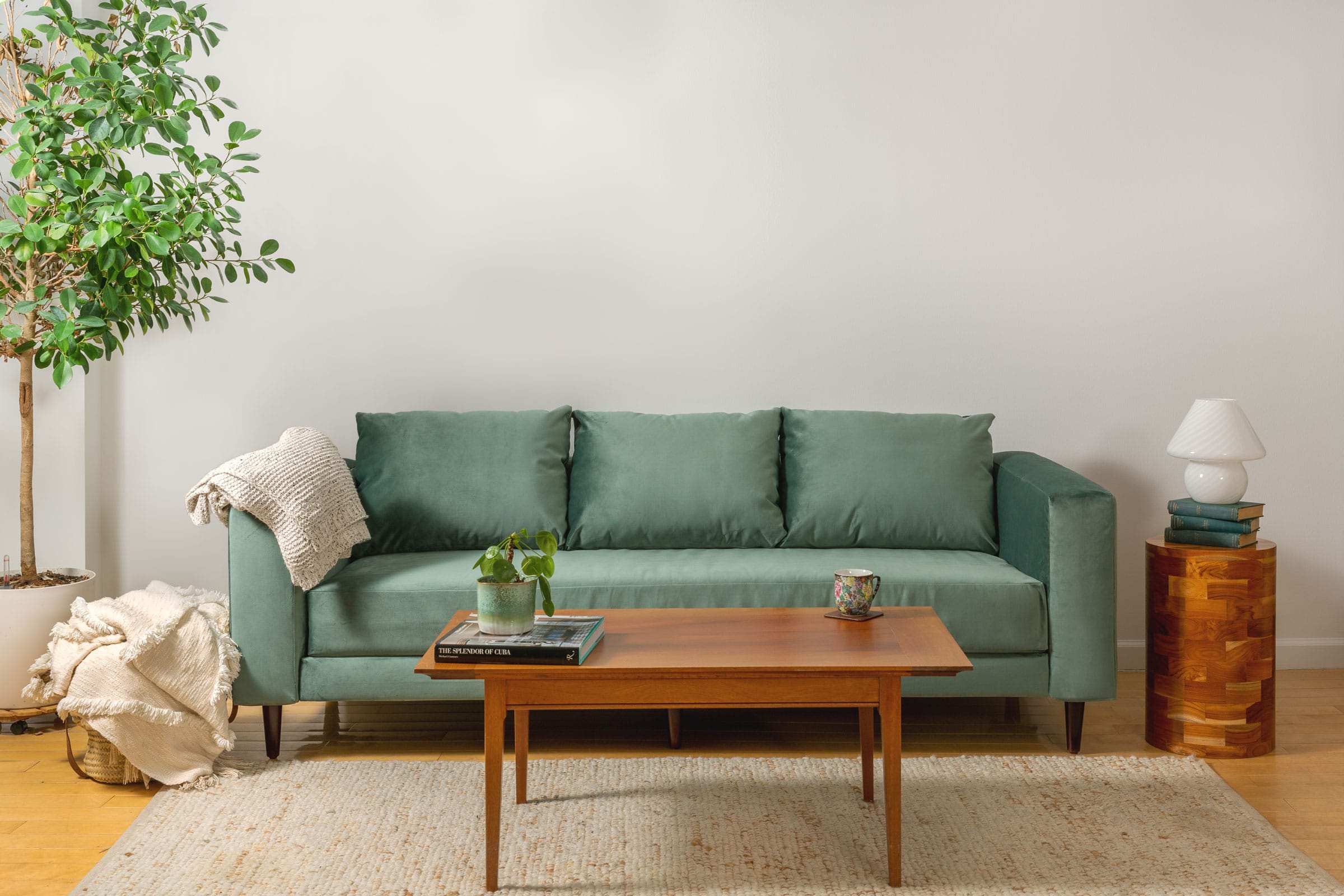Story at a glance:
- The Essential Sofa from Sabai is upholstered in 100% recycled velvet or up-cycled polyester.
- Humanscale’s Path Chair contains more recycled plastic waste than any other chair on the market.
- The Earth Stool from Mater is manufactured partially from plastic e-waste and coffee shell waste.
Though it may not make up the largest percentage of a building’s material footprint, furniture nevertheless has a significant impact on a project’s sustainablity, particularly as it relates to embodied carbon and overall lifetime emissions. This is largely due to the fact that the furniture industry as a whole expends massive amounts of energy on extracting and processing raw materials like wood, metal, and plastic.
In recent years designers and manufacturers have increasingly begun incorporating recycled materials into their furniture designs, reducing the need for new resource extraction and supporting the adoption of circular economic principles.
Here are 12 furniture designs made from recycled materials.
1. Path Chair
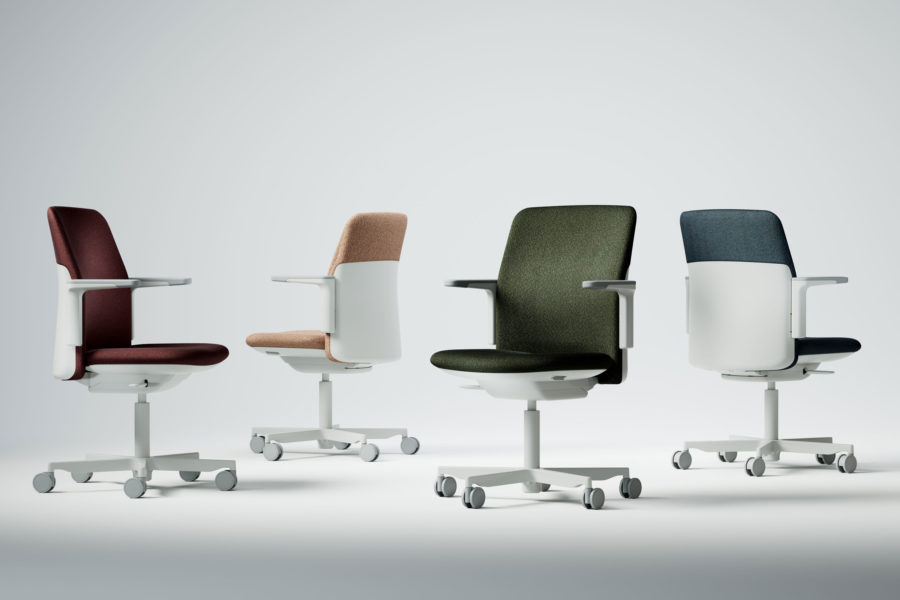
Humanscale calls its “Path” Chair the “most sustainable and ergonomically advanced task chair for every body.” The company aims to incorporate recycled materials in all of their furniture designs. Photo courtesy of Humanscale
Designed by Todd Bracher and the Humanscale Design Studio, the Path Chair is both ergonomic and sustainable—and it’s said to contain more upcycled plastic waste than any other chair in the industry. Each chair contains 9.49 pounds of ocean plastic—namely discarded fishing nets and yogurt cups—and features FormSense Eco Knit upholstery made from recycled plastic water bottles.
The Path task office chair is one of more than 25 Humanscale products that have achieved Living Product Challenge certification through the International Living Future Institute, meaning they go beyond having a net-zero environmental impact to having one that is actively climate-positive.
This commitment to regenerative design is very much in line with Humanscale’s philosophy regarding green, ethical manufacturing. “Design must also play a critical role in reversing the damage done to our environment,” Bob King, founder and CEO of Humanscale, told gb&d in a previous article. “The Path chair represents ‘a new path forward’ in design, prioritizing the manufacturing of products that not only create comfortable, beautiful working environments, but also push forward our use of sustainable materials and manufacturing techniques.”
In addition to being eco-friendly, Path is also designed to be universally comfortable, regardless of one’s height or weight. The chair is engineered to use the sitter’s weight and form to automatically adjust without the need for complicated manual controls, while the FormSense Eco Knit upholstery conforms to the body and provides self-adjusted lumbar support.
2. Essential Sofa

Courtesy of Sabai
BIPOC-owned furniture brand Sabai was founded with sustainability as one of its guiding tenets and demonstrates an unwavering commitment to circularity in everything they design. The Essential Sofa, for example, is one of many Sabai products upholstered in either 100% recycled velvet made from plastic water bottles or 100% upcycled polyester.
Free of both flame retardants and PFAS, the Essential Sofa is versatile, expandable, and available in a range of colors; slipcovers made from recycled or upcycled materials can be purchased as well for greater flexibility as ease of cleaning. The sofa is made-to-order to avoid undue material waste on Sabai’s end and is designed to be easily assembled with universal tools.
The Essential Sofa—like all Sabai products—is shipped in 100% recycled packaging via FedEx Ground, further reducing its environmental footprint. Sabai also encourages recycling and reuse through their Revive program, which makes it easy for customers to pass on furniture to a new owner should they ever need to part with it.
3. Tango Sectional
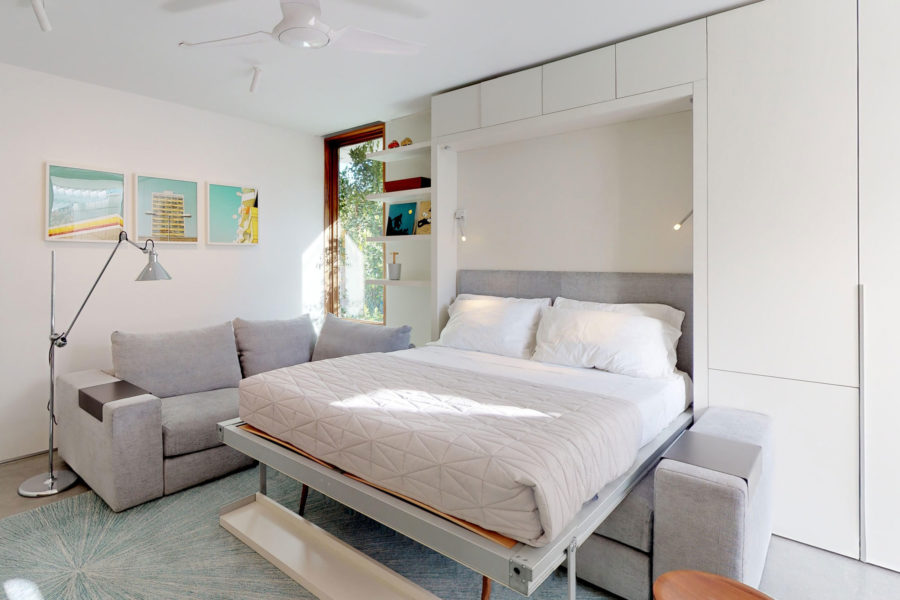
The Tango Sectional unfolds to include a bed, as seen in the Axiom Desert House. Photo courtesy of Resource Furniture
Designed and manufactured in Italy by CLEI, the Tango Sectional is a multi-functional piece of furniture that quickly transforms from a couch (complete with under-seat storage) into a queen-sized bed when opened. Engineered with both sustainability and practicality in mind, the sectional is built with 90% recycled or reforested wood and utilizes VOC-free paints, lacquers, and glues.
In addition to using recycled and eco-friendly materials, the sectional achieves sustainability by combining several pieces of furniture into a single unit, reducing a home’s overall spatial requirements and allowing for smaller building footprints that use land—and resources—much more efficiently.
“The Tango Sectional maximizes your existing space without compromising on comfort, quality, or style,” Ron Barth, co-founder of Resource Furniture—the exclusive North American distributor of CLEI furniture—told gb&d in a previous article. “By allowing a single space to do the work of two or three, we can physically occupy less space to build, heat, cool, and power. In this way, we can drastically reduce our carbon footprint by utilizing transforming furniture.”
4. WasteLAB Vox Sink
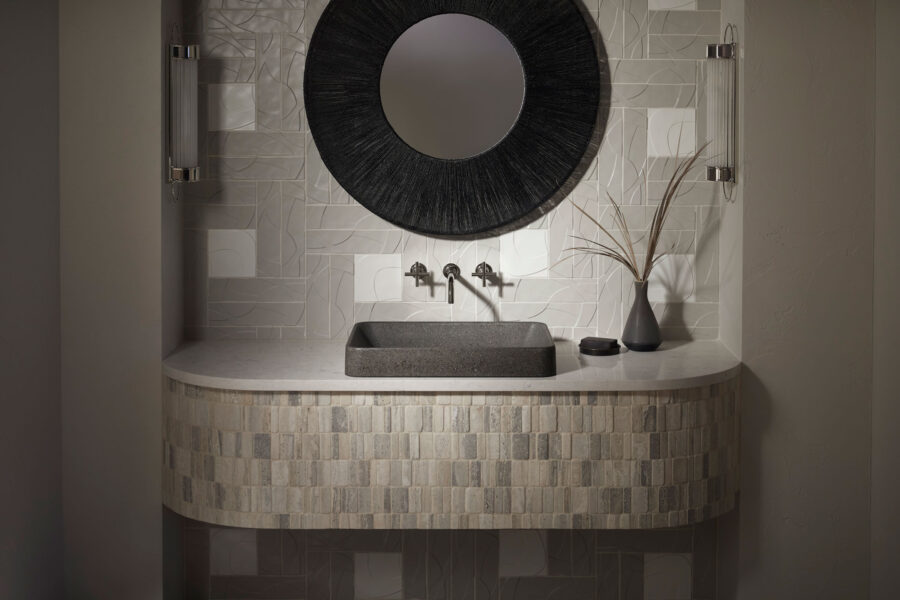
Kohler unveiled its first-ever WasteLAB sink at KBIS, made using recycled waste. Photo courtesy of Kohler
In 2019 Kohler launched WasteLAB as part of a campaign to find innovative uses for in-house factory waste. “Some Kohler associates came up with the idea like, ‘Hey, can we explore making cool stuff out of our factory waste?’” Stephen Maliszewski, director of public relations at Kohler, previously told gb&d.
Most of this waste is used to fashion WasteLAB tiles, though Kohler also offers the WasteLAB Vox countertop sink. Manufactured from at least 70% recycled materials derived from the Kohler manufacturing waste stream, the WasteLAB Vox sink is dyed using foundry dust, foundry sand, and vitreous cull from the cast iron process while the sink itself is constructed from crushed materials that don’t make it through the kiln.
5. COAST Bench
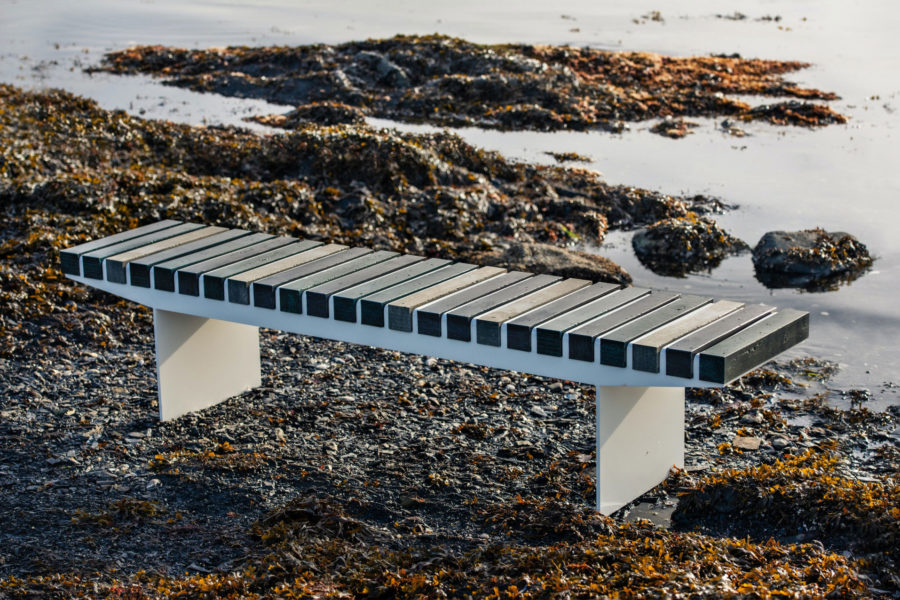
Photo courtesy of Vestre
Norwegian urban furniture manufacturer Vestre has long prioritized sustainability as a guiding business principle—and their COAST bench is proof of that commitment. COAST is the company’s first bench to be made from volunteer-collected ownerless ocean plastic, or plastic that has drifted for a long time before eventually washing up along the coastline.
“It’s an inspiring and gratifying task to design a bench that uses plastic collected from beaches with the help of volunteers,” Allan Hagerup, who designed the bench, said in a press release. “It feels really good to have created the first bench from this material for Vestre, and to contribute to sustainable development with a product that will be accessible to everyone.” Because the recycled material used to manufacture the COAST bench is not of a uniform quality, Hagerup built ease of part replacement into the product’s design to ensure long-term use and performance even if the plastic itself begins to degrade.
“When the material is of variable quality, it is important to consider what happens to the plastic over time outdoors,” says Hagerup. “To prevent erosion, the plastic must be replaced at regular intervals, through a deposit system or through a lease with regular servicing by Vestre. The frame is therefore shaped so that it is simple to replace the plastic parts as needed.” The replaced parts are then recycled once again for use in other products, effectively making the act of recycling an integral—and continuous—part of the product’s life-cycle.
6. Earth Stool
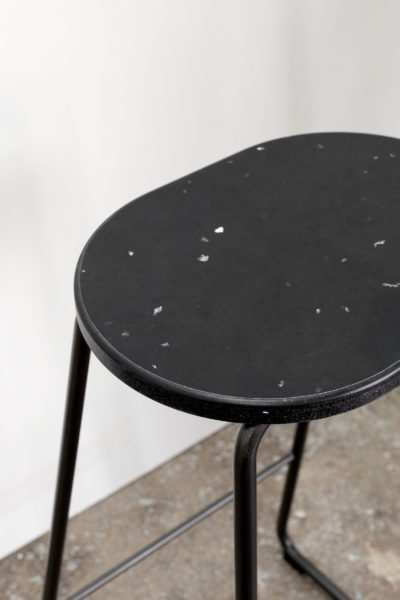
The Earth Stool was designed by Danish architect Eva Harlou for Mater. Photo courtesy of Mater USA
Designed by Danish architect Eva Harlou for Mater—an international leader in sustainable high-end furniture—the Earth Stool is a circular bar stool whose seat and optional backrest are constructed from Matek, a proprietary material made from recycled fiber and plastic waste.
The innovative material is made possible thanks to a novel waste-to-value technique developed in collaboration with the Danish Technological Institute with support from the University of Copenhagen and allows Mater to manufacture Matek from other companies’ waste. The Matek used to construct the Earth Stool, for example, is a mix of post-consumer e-waste and coffee shell waste from BKI Kaffe.
7. Bell Chair
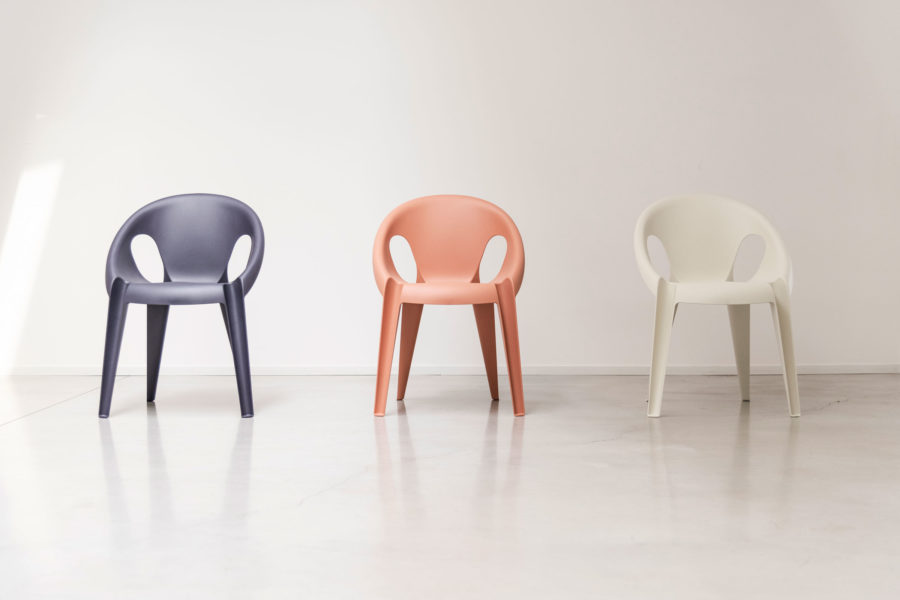
The Bell Chair was made using recycled polypropylene generated in Magis’ own furniture production as well as the local car industry. Courtesy of Magis
Magis’ Konstantin Grcic-designed Bell Chair is a lightweight, stackable chair made from recycled polypropylene obtained from waste generated by Magis’ own furniture production and from the local car industry.
Suitable for both indoor and outdoor use, the Bell Chair is available in four colors—Dawn, Sunrise, High Noon, and Midnight—and is 100% recyclable once it reaches the end of its operational life span, forming an almost closed-material cycle.
8. Flat Pack Side Table/Stool
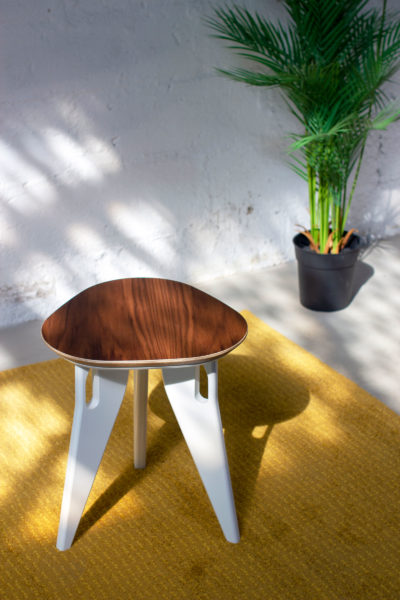
Photo courtesy of Hoek Home
Designed to be assembled in 60 seconds or less, the Side Table/Stool from Hoek Home is a simple, sleek piece of modern furniture that is as versatile as it is sustainable. The side table’s flat pack chassis storage design and patented one-click flexible joint securing system allows it to be assembled by hand in seconds—no instructions or tools needed.
In keeping with Hoek Home’s mission to promote circular design and reduce plastic waste, the Side Table/Stool uses 100% post-consumer recycled HDPE for its legs and underside, while FSC-certified plywood is used to construct the table’s core.
9. 1188 Outdoor Rug Collection
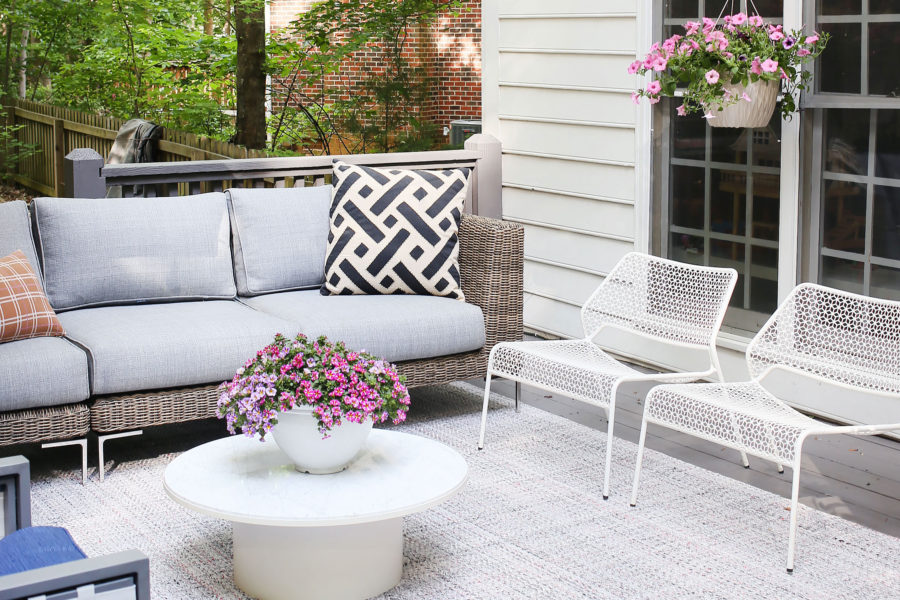
1188 Rug Collection. Photo courtesy of Outer
Crafted by Outer, the 1188 Outdoor Rug Collection is a simple, minimalist series of high-performance outdoor rugs designed to compliment a range of stylistic preferences. “Rugs are the unsung heroes when creating comfortable and stylish spaces,” Terry Lin, co-founder and chief design officer of Outer, told gb&d in a previous publication. “They are foundational pieces. We didn’t want the rug’s pattern or color to drive the aesthetics of a space, so we kept the look neutral with subtle texture and a herringbone pattern to ensure it fits within people’s decorating design style, whatever that may be.”
The versatility of the 1188 Outdoor Rug Collection is matched only by its incredible sustainability, something Outer strives for in all of their furniture. Manufactured from 100% recycled PET plastic, the collection takes its name from the amount of recycled plastic bottles—1,188, or the equivalent of roughly 12 years of plastic waste—required to produce the collection’s largest 9 foot by 12 foot rug.
Fashioning the rugs from recycled materials not only gives the plastic a second chance at life, but also imbues the rugs with incredible durability, as PET plastics are naturally stain-resistant, fade-proof, and weather the elements with ease.
10. RAY Sconce
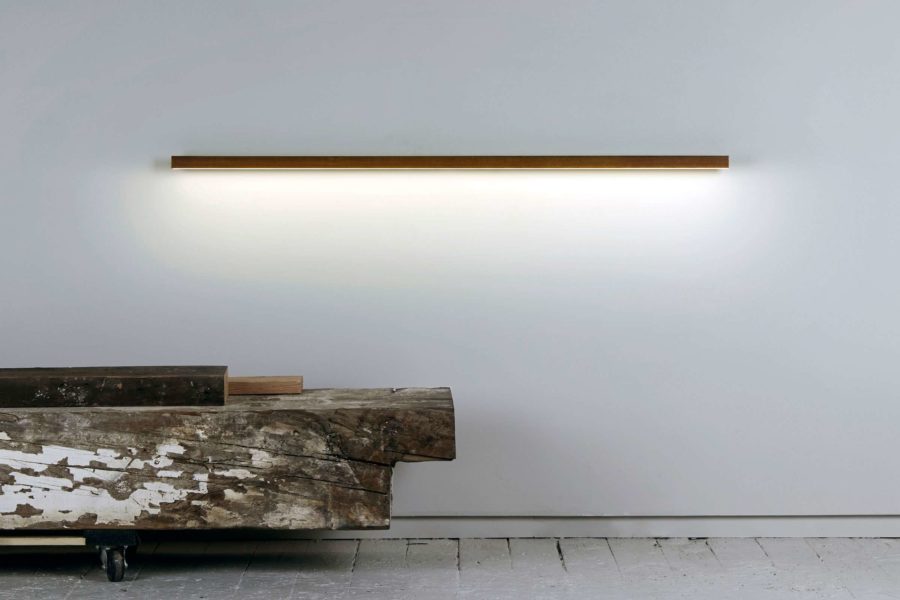
Stickbulb’s new RAY Sconce Collection incorporates sustainably sourced woods. Since its start Stickbulb’s mission has been to source only from demolished buildings, decommissioned water towers, trees that have already fallen down, and sustainably grown forests. Photo by Joseph De Leo
NYC-based lighting manufacturer Stickbulb is committed to using only the most sustainable and responsibly-sourced wood in their LED lighting fixtures. Many of the company’s products—like the RAY Sconce—are available in a range of wood species, the majority of which are sourced locally from sustainably-managed forests in New York and Pennsylvania.
Where possible Stickbulb aims to minimize the need for new resource extraction by reclaiming wood from local construction and demolition sites. All of their heart pine, for instance, is carefully selected from demolished buildings in and around New York while their redwood is sourced exclusively from NYC water towers.
The simplicity of the RAY Sconce—which consists of a single solid wood stick held in place by metal hardware—is intentional, casting the wood itself as the main focal point. “RAY is simple, clean, and quiet,” Russell Greenberg, co-founder of Stickbulb, previously told gb&d. “The design is so minimal it draws your attention closer to the subtle details of the wood grain and the machined precision of the sconce construction.”
11. Move Chair
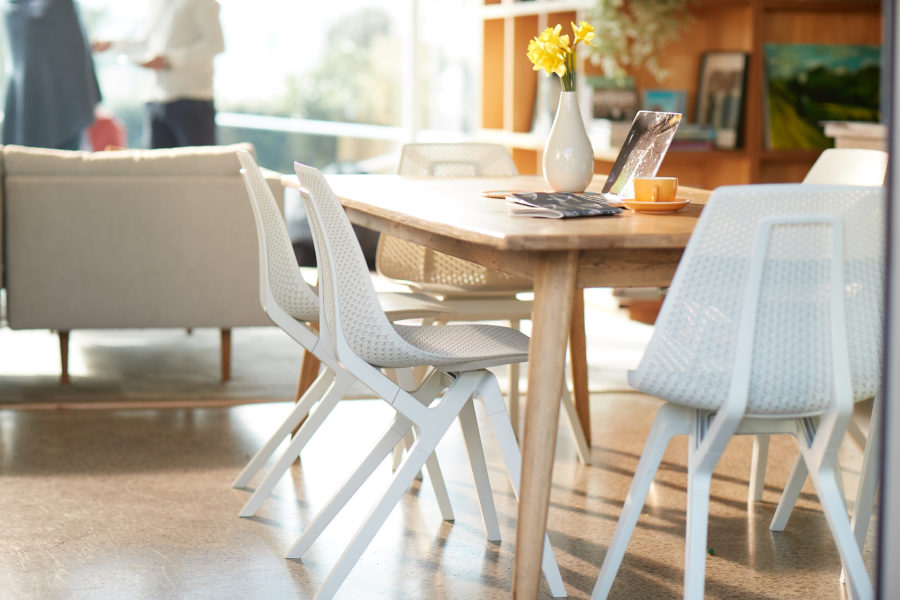
The noho move chair was made with ECONYL regenerated nylon. Photo courtesy of Aquafil
Designed by Formway for New Zealand furniture brand Noho, the Move dining chair is crafted from recycled post-industrial polypropylene and ECONYL regenerated nylon from Aquafil. All ECONYL yarn is manufactured using 100% post-consumer recycled plastic—namely reclaimed fishing nets and other plastic ocean waste—that is chemically recycled to ensure it retains the quality and performance of new nylon.
“We are very proud of our partnership with noho to help them bring their vision for this innovative chair to life,” Giulio Bonazzi, chairman and chief executive of Aquafil, previously told gb&d. “The noho move chair is the first furniture product made with ECONYL regenerated nylon and we are so excited to see what other eco-conscious furniture lines this will inspire.”
12. Seats for One Collection
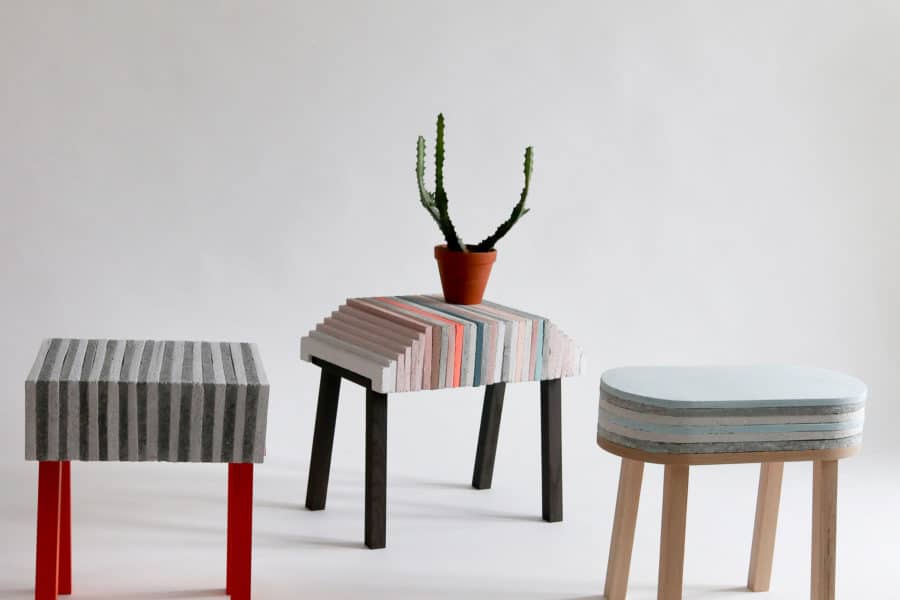
The Dear Human Seats for One collection uses solid post-consumer paper in its design. Courtesy of Dear Human
Launched in 2020, the Seats for One collection is a series of one-of-a-kind stools developed by the Dear Human art collective in collaboration with Papertile—a Montreal-based firm that specializes in wall coverings made from 100% post-consumer recycled paper—and includes the Dutch, Oval, and Ziggurat stools (although Ziggurat is the only stool still available).
Characterized by unique shapes and pops of color, the stools are intended to be playful and endearing, honoring and drawing inspiration from cultures around the globe. “World folk traditions are big [parts] of just about everything we make,” Noel O’Connell, cofounder of Dear Human and Papertile, previously told gb&d. “For Seats for One, although some technology is used in making them, they are still very much made by hand in ways that ancient stools would have been made. Color and pattern and how we combine them are inspired by folk craft as well, from textiles, tiles, basketry, etc.”
The legs of each stool are constructed from oak while the seat-tops themselves are fashioned from Papertile’s innovative recycled paper panels. All Papertile products are manufactured from post-consumer paper collected from local businesses and are produced in such a manner so as to ensure a minimal environmental impact.

